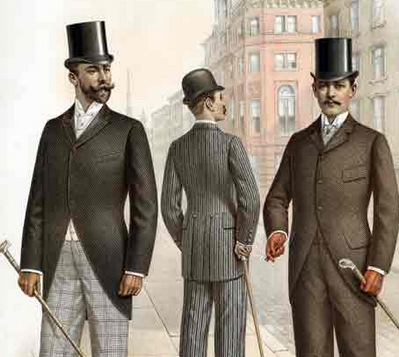What Makes a Modern Suit: A Look at Suits From the 1930s to 2013
Angela Prickette, March 20 2013

Truly the workhorse of a man's wardrobe, the suit has survived over the centuries by adapting its design to meet the needs of the period. While worn historically to complement the lifestyles of aristocrats and well-to-do businessmen, suits truly became a method of expression for all modern men in the early decades of the twentieth century.
In the 1930s, fashion was highly influenced by glamorous film stars of the age. Celebrities like Clark Gable and Henry Fonda dictated the latest trends. Men's fashions reflected the decadence seen on the silver screen with double-breasted suits, full-cut trousers and tuxedoes with tails.
By the Second World War, restrictions on fabrics prompted more simplistic designs. Jackets became single-breasted and trousers lacked significant detail. The gray flannel suit became a cultural icon of the times.
Mid-century menswear reflected the Jekyll and Hyde nature of modern society. Men achieved conformity by day with trim tailored suits featuring slim lapels and pocket squares. By night, they dressed as part of the Brat Pack with shantung jackets and velvet collars.
The 1960s took men's tailoring to new levels with creative cuts and expressive prints. Skinny mod suits and flared trousers were contributions made by the Beatles and Hippie counterculture, respectively. Turtlenecks and neckerchiefs also became acceptable complements to the modern suit.
The "Peacock Revolution" continued into the 1970s and featured floppy collars and exaggerated lapels. The three-piece suit became standard attire at discothèques. The suit became a canvas where flamboyancy was celebrated.
The 1980s was another era marked with dichotomy. Wall Street types wore suits featuring broad shoulders, suspenders and a "power tie". Others, influenced by shows like Miami Vice, wore pastel shirts with loosely tailored suits. If a tie was worn, it was invariably thin.
The 1990s introduced minimalism into menswear. While suits early in the decade were loose, slimmer silhouettes dominated the end of the century. Black suits worn with white shirts and thin black ties became the uniform of the modern man.
The twenty-first century gave rise to the "metrosexual". While suits maintained slim cuts, velvet fabrics, and lapel pins from Trend Corporate were used to express individualism and modern style.
The 2010s includes trends from the past, such as slim lapels and trousers short of the ankle. While these features are nods to mid-century looks, the modern suit features luxury fabrics like shiny mohair to give it an air of distinction.
While the basic pieces of a suit will seemingly never change, its features certainly evolve to give it timeless appeal.
